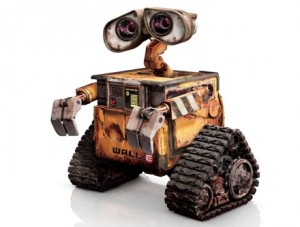I see many robots designed by students that share a striking similarity to Disney/PIXAR’s character WALL-E. I find that this is often not dependent on the robotics platform chosen by the school and happens in from scratch projects as well. The basis behind these designs would seem to stem from the tasks that the robots are designed to perform. Tasks that, not unlike those performed by the tenderhearted and personified WALL-E, require three major components:
- Chassis & Drive System
- Control Unit
- Tool/Manipulator
What we see invariably with the tasks given to our classroom robots is a standardized design. There is of course nothing wrong with this, but it may serve to limit the imagination of the student and contribute to the already fictionalized false image of the robot. Robots of today are not always based on four wheels with a retractable claw bearing arm, for example. There are some schools out there, however, that have moved their designs outside of the WALL-E box and into a realistic realm completely dependent upon needs identified in their schools. Here is my favourite example of a real world robot that I have seen brought to life in school.
 In one science class in Manitoba the students are conducting in depth environmental experiments into the rain water run-off and wetland water exchange by testing the temperatures of different samples within the wetland at a range of different times. This is an experiment that would require a large number of students and many hours of work. Here, however, students from the robotics class and the science class have combined their efforts and designed a robotic water craft operated by remote control. This robotic boat takes the temperature readings with an on board data logger and stores the data until it is collected. This extremely advanced idea was built using VEX robotics hardware and the Fourier Ecolog XL. The next generation design includes GPS guidance for autonomous control, allowing day and night operations and fixed point and time data retrieval.
In one science class in Manitoba the students are conducting in depth environmental experiments into the rain water run-off and wetland water exchange by testing the temperatures of different samples within the wetland at a range of different times. This is an experiment that would require a large number of students and many hours of work. Here, however, students from the robotics class and the science class have combined their efforts and designed a robotic water craft operated by remote control. This robotic boat takes the temperature readings with an on board data logger and stores the data until it is collected. This extremely advanced idea was built using VEX robotics hardware and the Fourier Ecolog XL. The next generation design includes GPS guidance for autonomous control, allowing day and night operations and fixed point and time data retrieval.
This is just one example of how students are combining real world needs with the concepts they learn from robotics. I encourage everyone to look around their school and identify a need; a need which will one day develop into the next household or industrial robot.
We at Studica are always a proud part of the design and discovery process. If we can help you develop the skills and imagination in your students that they will use in the future world of automation please let us know.
Author: Matthew Colbeck
Share this Post

